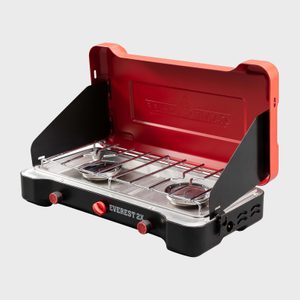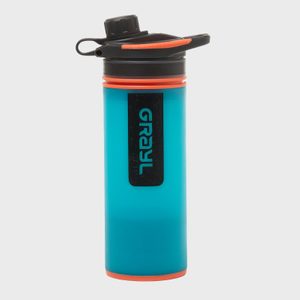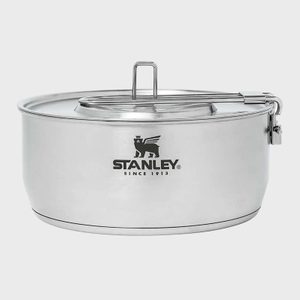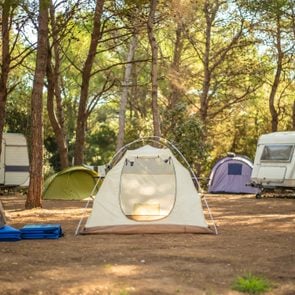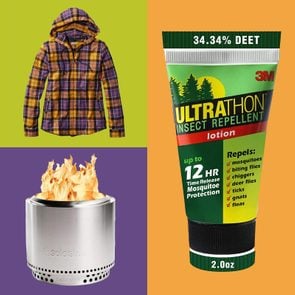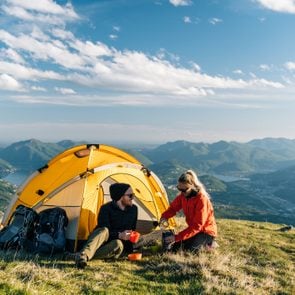Camp Cooking 101: A Tasty Guide to Cooking While Camping
Updated: Mar. 13, 2024

Enjoy the beauty of nature while savoring delicious meals, thanks to this handy guide to everything camp cooking
Our editors and experts handpick every product we feature. We may earn a commission from your purchases.Learn more.
The best part of camping is the opportunity to spend time in nature, unrestrained by walls. But you do still have to eat. And while camp cooking comes with some challenges, such as the lack of stove, oven and sink, it also comes with lots of perks, including the chance to get creative and cook up some dishes that really do taste better outdoors. As long as you have the right camping gear and one of the best coolers for camping, you’ll be able to make tasty meals that will draw you back to nature again and again.
We spoke with camp cooking experts to get the skinny on everything you need to know to smoothly and deliciously cook while camping—and yes, this even applies to camping for beginners. Read on for all the details.
Get Reader’s Digest’s Read Up newsletter for more camping tips, humor, cleaning, travel, tech and fun facts all week long.
Cooking gear for camping
How much cooking gear you bring on your camping trip is going to depend a lot on how you get to your campsite—if you’re driving in, you can bring much more than if you’re walking or hiking.
“For me, the truly essential gear would be a stove, pot, water filter and a knife,” says Ryan Cunningham, founder of the camping website Beyond the Tent. “When I’m on a canoe camping or backpacking trip, these are my truly essential pieces of gear. I can do almost anything with them.” Indeed, with these four tools, you can prepare and cook just about anything, and you’ll always have clean water you can use for drinking and cooking.
If you’re taking a road trip to a campsite or parking in an RV park, your options for cooking gear begin to expand. “For camping adventures where I can bring more gear, I like bringing more plates, silverware, frying pans and even a small grill if I can,” says Cunningham. “Dutch ovens are incredibly versatile and can be used for almost anything when camping. But they are heavy. Cast iron is also great for cooking over a fire.” These will expand your options for the types of food you can cook and will make the eating experience a little more comfortable.
Other gear you might want to consider bringing: a cutting board, a spatula, tongs, a can opener and bottle opener, a coffee maker (such as a percolator or French press) and a basin, soap, sponge and quick-dry towels for washing dishes.
How to pack your food
It doesn’t matter if you have the best tent, best sleeping bag, best camping cot and best camping chair—if you don’t pack your cooler intelligently, you’re in for an unpleasant camping trip. The first step to proper packing is prepping your food.
“To save space, you will want to prepare as much of your camping food at home as you can,” says Megan McDuffie, co-founder of Fresh Off the Grid, a site dedicated to cooking for camping and backpacking. “Pre-chop your veggies, and make marinades ahead of time. Portion out condiments into smaller vessels if you don’t need the whole bottle. The less space the food takes up in the cooler, the more room there is for ice.”
From there, make sure all your food is in watertight and airtight packaging. “For long trips, you will want to freeze as much of your food as possible,” adds McDuffie. “Everything that is not being frozen should be refrigerated before being packed.”
In terms of ice, McDuffie recommends aiming for a 2:1 ratio of ice to food in your cooler. And if you can use large blocks of ice or frozen water bottles, do it. Those will stay frozen longer than cubed ice.
All that said, keep in mind that a fully packed cooler is likely going to get heavy. For car camping, this isn’t much of an issue, as you can leave the cooler in the back of your truck or move it from the car to the ground. But if you’re trekking to a campsite on foot, not even the best hiking sandals, hiking socks or hiking boots for men or women are going to make carrying a heavy cooler easier.
The final consideration for packing your food is whether or not you’re in bear country, says Cunningham. “If bears are a real threat, then I am probably not packing anything that needs to remain cold,” he says. “Instead, I’m packing all my food into a bear-safe container or a bear-safe sack [like Ursack].”
How to set up a kitchen
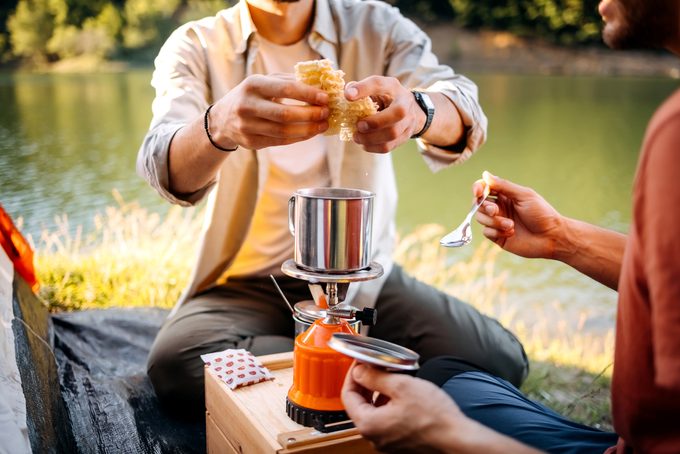
Where you set up your camp kitchen depends on where you’re camping. Are you staying at a campsite or roughing it in the woods? Or are you going upscale with a luxury camping adventure, yurt camping or glamping?
“If you’re at a developed campsite that has a picnic table, we find it makes the most sense to set up the kitchen near (or using) the table,” says McDuffie. That way, you can use it as a space to prepare food. If your campsite has electricity and/or a water source, you may want to be near those as well; it’ll help you avoid shuttling dishes back and forth across your campsite.
“If the campsite is more primitive, you’ll want to set up your kitchen on a flat, hard-packed surface,” McDuffie suggests. “And try to avoid setting it up on grass to avoid damaging the vegetation.”
Regardless of the type of campsite, Cunningham recommends always setting up your kitchen a good distance away from where you’ll be sleeping. “It’s inevitable that bits of food or strong food smells will linger around your kitchen area, and you don’t want animals of any kind visiting you in your tent at night,” he says. Positioning your kitchen downwind from your tent will help as well.
When you’re ready to close up the kitchen at the end of the night, first make sure there’s no food in your tent. “Rodents that frequent campsites are notoriously persistent and have been known to chew through soft-sided storage, like a tent,” McDuffie says. Then thoroughly wash all your dishes and cooking tools and stow them away. Finally, stash your food.
“Ideally, all food should be stored in hard-sided, critter-resistant containers, like a cooler, a sturdy plastic bin or in your vehicle,” says McDuffie. Cunningham recommends picking up a cooler that locks or placing straps around your cooler. And if you’re in bear country, make sure you have a bear-proof container or sack. (Here’s what to do if you see a bear, by the way.)
Types of camp cooking
There are a few different ways to cook while camping, depending on the gear you bring with you and the space and resources at your campsite.
- Cooking with a camp stove: Camp stoves use propane and work the same way as the stove in your kitchen at home, which means you are able to make all the same things. They are easy to transport and don’t require you to build a fire in order to eat.
- Cooking over the fire: Some people may consider cooking over an open flame a requisite for the full camping experience—plus, once your fire is burning, you have somewhere to tell campfire stories and sing campfire songs when you’re finished eating. But to do more than roast marshmallows, you’ll need a couple extra pieces of equipment to cook over the fire. McDuffie recommends picking up a portable grill, some heat-resistant gloves and a cast-iron skillet and/or Dutch oven.
- Cooking with a portable grill: Your third camp cooking option is to use a portable grill. These come in propane- and charcoal-fueled models and will help you achieve that fire-cooked flavor without the uncertainty of cooking over an open flame.
How to clean up
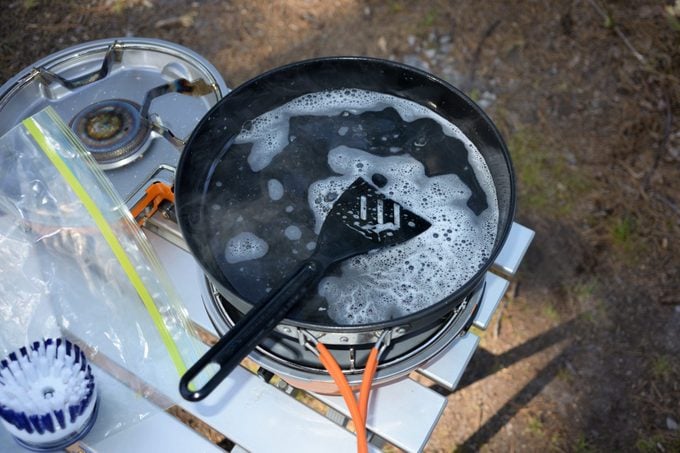
Ensuring that you have a quick and easy cleanup starts before you even leave your house.
“If you repackage food before your trip, you don’t have that excess trash to pack out,” says McDuffie. “Take drinks, for example. You don’t need to bring along the cardboard box that cans come in. Pack the cans in the cooler and ditch the cardboard box in your home trash or recycling bin.” Preparing ingredients before you pack them will also reduce food waste at the campsite.
If you’re thinking ahead of time about the fact that you’ll need to take out all the trash you bring in, it will likely help you pack smarter, notes Cunningham. “Nobody wants a backpack full of trash, so you’ll naturally start being more efficient with it,” he says.
When you’re almost done packing up your campsite, adds Cunningham, have everyone in your party do a walkthrough to pick up any trash you missed and return anything you may have moved, such as sticks or rocks, back to where they were before you arrived. That’s one of the main tenets of the “leave no trace” philosophy of interacting with nature.
What to eat while camping
Once you have all your gear and all the proper tools, your options for camping meals are almost endless. Below, we’ve rounded up some of our favorites.
For breakfast:
- Pancakes
- Frittata
- Skillet cornbread
- Yogurt and granola
For lunch:
- Campfire nachos
- Chicken kebabs
- Peanut butter and jelly
- Grilled cheese
For dinner:
- Chili
- Hamburgers or cheeseburgers
- Macaroni and cheese
- Foil-packet fish or shrimp and vegetables
More tips for camp cooking
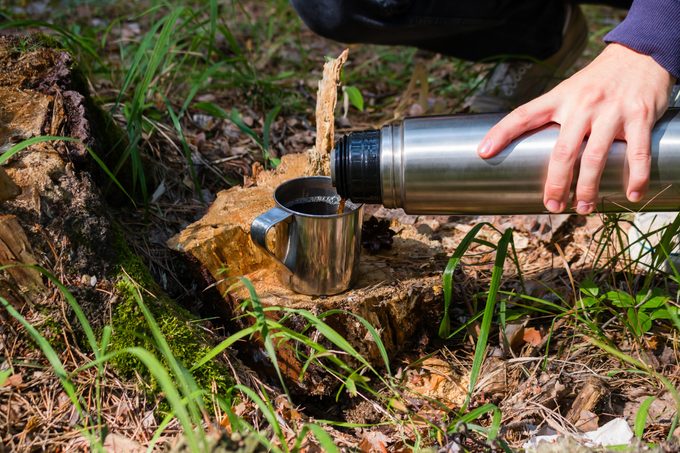
- Don’t forget hot drinks. Pack some coffee, tea or hot chocolate alongside all the refreshing beverages in your cooler. “They can make a cold evening or morning much more enjoyable,” Cunningham says.
- Reheat on night one. “It’s great to cook or prep your first night’s meal at home and then just reheat it at the campsite,” says McDuffie. “There are so many chores to be done when you first arrive—setting up the kitchen, the tent, etc.—and it can really reduce the stress to have dinner already taken care of. That way, you’ll be able to slip into relaxation mode so much quicker!”
- Always start early. “Start cooking a bit earlier than you think you need to,” says McDuffie. “If all goes to plan, you’ll just eat dinner a little early, but if there are any hiccups along the way, at least you won’t be eating and cleaning up in the dark.”
Now that you’ve got camp cooking down pat, it’s time to watch some fun family camping movies for inspiration before you head out on your own.
Sources:
- Ryan Cunningham, founder of Beyond the Tent
- Megan McDuffie, co-founder of Fresh Off the Grid
















